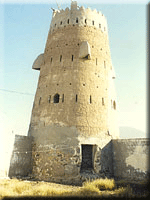
National
Museum
RAK National Museum has been established in
1987 according to an ordinance from His Highness
Sheikh Saqr Bin Mohammed Al-Qasimi, the Ruler
of RAK in Al Hisin. This Hisin was built in
the middle of the 18th century. It is located
in the old RAK town after maintenance.
The
Museum consists of so many parts most important
of which is the Qawasim Room on the first
floor. It contains documents, manuscript and
treaties between the ruling family and the
U.K. Government, and also some traditional
weapons belonging to the Ruling Family.
The
other important part is the one allotted for
the antiquities, which were found in different
parts of the Emirate. Age of some of these
antiquities refers to 5000 BC, and some of
them refer to the Islamic age. These antiquities
are exhibited on the ground floor of the museum
and they are arranged in historical order.
There is also a room for silverware used by
women for decoration.
Al
Hisin
It was built in the middle of 18th century,
during the Persian occupation between 1730-
1749. Most of the modern buildings inside
it were built in the last 100 years.
It was used previously as a residence to the
ruling family up to 1964, after wards it was
used as a location to the general directorate
of RAK Police, and later as a central jail
up to 1984.
In
1987 His Highness Sheikh Saqr Bin Mohamed
Al-Qasimi decided to use Al Hisin as Ras Al-Khaimah
National Museum after maintaining it and reconditioning
it using the original Local raw materials.
Ras
Al Khaimah national Museum contains many antiquities
explored in the emirate. It is considered
to be one of the richest museums in UAE. There
are so many annexes added to the museum, one
of which belongs to the ruling family named
Al-Qasimi annex.
There
are also the heritage annex and rooms for
the jewelleries, clothes (dresses), traditional
weapons and native history. It has a section
for archaeology, which contains a Lab rotary
for classification and determination of the
ages of the findings in co-operation with
some European universities.

Shamal
Shamal soil is considered to be the most fertile
in the Emirate. Some tombstones were left
in Shamal since last thousand years. Many
important Locations were found back to the
oasis near the mountain. It is easy to reach
there using Shamal main road. Beside the new
road a big grave has been found which refers
to Um Al Nar age, its date is about 4500 years.
This grave is circular with a diameter of
14.5 meters. It is considered to be the Largest
found in UAE. It was built with decorated
walls; it was full of findings, which have
been shifted to the museum. These findings
show the Um Al Nar civilization was very rich
and her people were skilful.
Wadi souk culture left behind a large graveyard
containing so many graves from 4000 years
back. They are very rare graves and unique
in the Emirates. These graves were found only
in RAK. Some of these graves contain Maglethian
characteristics, already excavation of these
graves is over and the sight can receive visitors.
On the mountain, on the high point of new
Shamal village there is a palace which reverts
to the middle ages and it is the only palace
found in UAE This palace is known in the mythology
science as (Al Zabba’a Palace), although
that queen lived in prior period to that palace
building time.
Water
tanks and defending walls were built on the
hill at Shamal, but the palace was built in
the front side of the hill. It has a look
out on the Shamal fertile valley.
So
many rooms and water tanks are available there.
The original roofs are still there as a sign
of the brilliant and skilled past. This palace
had connection with Julfar trading town, Julfar
was the name of RAK previously.

Al
Falaya
The houses of Al Fillaya were built in the
18th century as summer lodging for Al Quasim
Family. These houses were surrounded with
palm gardens; also the locals from RAK to
spend the summer time there used some houses.
Historically
this location is considered to be important
because the peace treaty between the Quasim
and the Oman's British armed forces was signed
there in the year 1819.
In
the year 1820 a peace treaty was signed between
the Sheikhs of the Arab Gulf Coast and the
British Government at Al Fillaya. Due to this
treaty and after a small period UAE has been
established.

Watchtowers
Everywhere in the fertile valley of RAK a
visitor can find signs of the past where fighting
was something normal between the people. The
watchtowers are about 60 towers, most of them
have been maintained and reconditioned and
the rest are still as they are.
These
remaining towers are the evidence for the
strong defence net which protected the lands,
palm trees gardens and the village of RAK.
On the hills, highlands and some times in
the centre of palm oasis these watchtowers
were built with the hands of skillful soldiers
as a protection from any enemy they can face.
|






